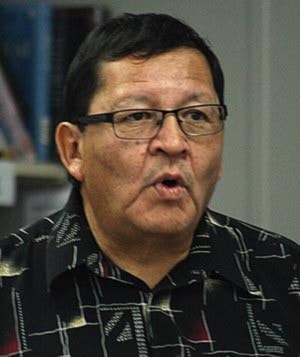Historical agreements made by the British Crown and Canada’s first government continue to impact the lives of those living in the four bands of Maskwacis.
To commemorate the 50th anniversary of International Literacy Day and September as Treaties Month, Maskwacis Cultural College hosted a public treaties lecture, Sept. 8, outlining the history of treaties and First Nations treatment in Canada.
Presenter Bruce Cutknife, Samson Cree First Nation member and Indigenous education co-ordinator for the Nipisihkopahk Education Authority, says treaties were made between different tribes and between First Nations and European authority.
Cutknife says there are many common misconceptions surrounding treaties, including ‘we’re all treaty people’ and ’ the treaty is the law of the land.’ “It (treaties) made Canada what it is.”
He added just in more recent years the governments of Alberta and Canada began to recognize the impact of the treaties and what is treaty land. “That’s a start.”
“Now a treaty is not an armistice,” said Cutknife, meaning the ratified treaty did not necessarily end war conflict the way an armistice truce would.
As current-day Canada was settled by Europeans treaties were signed between the two cultures, allowing for European development.
“One of the first treaties in Canada was the Treaty of Montreal in 1701,” said Cutknife.
He showed atendees of the lecture an artist’s rendition of the treaty signing in which First Nations people sat on the ground and European representatives were in chairs. “There’s a hierarchy.”
Cutknife says during the fur trade era trappers and traders were sometimes found to have “gone Injun” and during the Seven Years War French troops found more success using First Nations guerrilla tactics.
“In Indigenous culture you could rise in your station,” said Cutknife.
Other noteworthy treaties Cutknife mentioned in his lecture was the Treaty of Portsmouth, the Treaty of Paris and the Royal Proclamation. “It recognizes us as being occupants. No owners, occupants.”
During negotiations First Nations tribes were sometimes left with less than they bargained for, partially due to miscommunications and improper translations.
In Treaty 6 a medicine chest clause was included, leading to simple first aid kits stationed at lndian Agent houses for the betterment of the tribespeople. However, the First Nations wanted more comprehensive and equal medical care.
Cutknife says 56 treaties were signed between 1760 and 1923.
“There were promises of reserves of land … schools … farm implements … prohibition of the liquor trade … granted hunting and fishing rights forever … lump sum cash payments,” said Cutknife.
He added First Nations people struggled with the idea the British Crown then the Canadian government could grant them pieces of land when they lived off the land before the settlement.
In 1871, when British Columbia joined the confederation the province needed the right of way for the railway. “They started the biggest treaty expedition,” said Cutknife, referring to treaties 1 through 7.
“Any place you have different people and different beliefs you’ll have conflict,” he added.
In 1855 the Buffalo Treaty was signed. “This was a treaty within the tribes when hunting buffalo,” said Cutknife.
“Now treaties have been around for thousands of years,” he added.
Cutknife says the phrases “eh wi tas ke cik, witas kiw win, and e wih taski ma cik” translate to “they agree to share the land.”
He also shared the legend of Witaskiwin 1867 between the Cree and Blackfoot. Cree Chief Little Bear and Blackfoot Chief Buffalo Child were fighting and neither were gaining ground; a break was taken from the conflict. “One of them lights the pipe … they smoke the pipe together. They created peace without intending to.”
Cutknife was born and raised on the Bear Hills Maskwacis community and attended the Ermineskin Residential School up until Grade 9 and then moved to Edmonton to attend High School. In 1974 he completed high school in Ponoka.
Cutknife went back to school at Maskwacis Cultural College in 1976; eventually starting work in the Living History Program of the Maskwacis Cultural College. He also graduated with Bachelor of Arts in History and Native Studies from the Augustana University College. Cutknife worked in local radio and television, taught Cree language, Cree studies and history courses at the Maskwacis Cultural College. He is also the director of education for the Samson Cree Nation.
